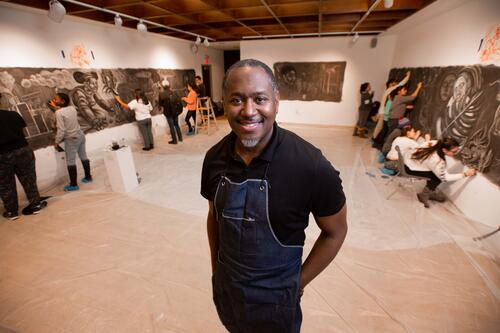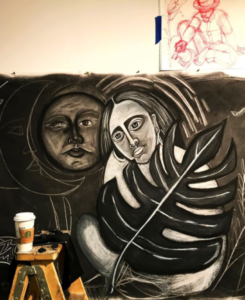Black authors are not as represented in literature as white authors, and thus “black literature is taught as sociology, as tolerance, not as a serious, rigorous art form”(Toni Morrison). In class, we watched Chimamanda Adichie’s TED talk about the problems “single stories” create. Adichie tells of how the single story of Africa inhibits African writers, like herself, from receiving the same recognition as white, western writers. She explained how living in Africa, she grew up reading books with all white characters. When she submitted a story, a professor told her it was not “authentically” African, even though she herself was an African writer. This problem circles back to Morrison’s idea that African American works of literature are often depicted as less than serious works of literature and art, and are expected to convey the “single story” of being African American. Great works of literature written by African Americans should be recognized as such.
The Personal Growth I Have Been Looking For
I look at the blank screen in front of me and frown. I feel my ears grow hotter and hotter as I stare at the blank word document. On the bottom right screen, the digital clock read: 8:30pm. It was originally 5:00pm and before that, it was 11:00am but it managed to get this late.

Continue reading “The Personal Growth I Have Been Looking For”
My Future Classroom Awaits
To be honest, I really did not know what to expect coming into this class. I have never taken a class that focused this kind of context, however, I have already found my future teacher self very inspired. I am a junior English major striving for a certification in adolescent education. Within my education classes over the past two semesters we have spent much time discussing how to connect and engage students of many different backgrounds and cultures. I have concluded that it is important to include a wide range of curriculum that would attract a wide range of students and yesterdays in class activity only enhanced that understanding
After participating in the straddling activity, I found myself thinking about the activity in terms of education. This activity made it clear that every person has their own personal way of dealing with obstacles and struggles. When the activity was over, and we were all describing our experiences with the activity, no two people described the same experience. I found this very captivating due to the fact that the activity exhibits the diversity among all of us as humans and I think that idea is something teachers should always have in the back of their minds.
It has been empowering to me that so much of what we have already discussed within this class has already got me thinking about how I could apply it to my future classroom. Out of the course epigraphs one that has stood out to me was said by Dionne Brand and it states, “my job is to notice… and to notice that you can notice.” I found this epigraph very fitting when thinking about my future. I believe that every teacher should strive towards creating a safe and understanding environment that puts an emphasis on the importance of noticing, accepting, and implementing curriculum based around different cultures and backgrounds.
We All Straddle in Some Way, Shape, or Form
After participating in the activity we did in class today, it give me a visual of what straddling really is. As mentioned in class, all of us took on the activity in a different way. Some of us were born naturally with longer legs, making it a little easier to straddle the two lines, whereas, others struggled more since they were born with shorter legs. Unfortunately, we cannot choose how short or how long our legs are, giving us all a different experience. Others focused too much on how they appeared to others, making it more difficult and others embraced how ridiculous it looked, making it easier. When there was an obstacle put in our way, some of us just stopped, some of us went right around it and continued straddling which shows how differently everybody handles straddling these two worlds. At the end of the day, I believe that we are all straddling and trying to balance these two worlds regardless of what they might be. Continue reading “We All Straddle in Some Way, Shape, or Form”
What We Talk About When We Art
“My job is to notice…and to notice that you can notice.”–Dionne Brand
To be quite frank, I felt an immediate sense of excitement when I learned that Geneseo would be offering INTD288, a course exploring Steve Prince’s art. Maybe the exhilaration I felt about taking this course was that it was [FINALLY] something that called out to me. Seeing the catalog and description for this course instantly struck me. Glimpsing at Prince’s work attached to the informational flyer about the course left me feeling completely and utterly enthralled. Perhaps this great sense of enticement was rooted in the mere fact that Prince’s work is very vocal; it’s demands to be seen, listened, and heard. I wanted to know more about the artist behind the piece. With its bold, expressive linear figures and its sense of movement throughout the work, it is pretty much impossible (if not very hard) to not be compelled in learning more about the person behind the work. Almost instinctively, I knew I had to be a part of this experience and even more so, I knew that this was an opportunity to be involved in something I believed to be important and in something that actually interested me–ART. It was refreshing to say the least.
The first week I experienced for this course was incredible! From listening to some snazzy tunes and having lively conversations with one another, to getting down and dirty with some charcoal blocks, what was there not to love?Getting to learn about Prince and carrying out a conversation with him was practically brain food. It nourished my mind, not only by allowing me to self reflect, but by allowing me to learn the way in which art can be used as a tool in learning how to reconnect with one another. The experience gained from contributing to the Urban Garden truly placed this into perspective. During one of my conversations with Prince, he told me that what he values the most about his work is the process in which it takes to create something. Creating something out of nothing is an extraordinary feeling and it is this process that opens up a space for conversation between one another. Having worked along side with Prince and everyone else who contributed to the Urban Garden project, I can easily say I agree.

(the piece I created for the Urban Garden)
I Do Belong in this Space and So Do You
Reading the epigraphs in the course’s syllabus, I felt somewhat empowered. The one that really stood out to me is Dionne Brand’s quote, “my job is to notice…and to notice that you can notice.” To me, this is a self-reassuring statement in the sense that I, as a non-English discipline of any sort, can exist in this space and that my experiences are relevant and valid to the discussions we have in class. Continue reading “I Do Belong in this Space and So Do You”
A Threat or a Call to Action?
Throughout our class time we have discussed recursion in the grander sense: in major events such as life and death, seasons and the spin of fortune’s wheel. On the other hand, in the midst of these dense topics, I wonder where recursion occurs in the day to day. I wonder how the patterns that people fall into on a daily basis can be informed by a grander scale, and what the effects of that collision are like.
Everybody’s Words Matter
Toni Morrison said, “Word-work is sublime, she thinks, because it is generative; it makes meaning that secures our difference, our human difference – the way in which we are like no other life. We die. That may be the meaning of life. But we do language. That may be the measure of our lives”. I was particularly drawn to this epigraph because Morrison is talking about how much our words, whether it be through writing or dictated, is important in recognizing each of our lives and telling our stories.
In Chimamanda Ngozi Adichie‘s TED Talk, “The Danger of a Single Story”, Adichie presents multiple examples of how individual’s were seen differently because others bought into believing one story. In one example she talks about how Africa was seen as a country as opposed to a continent made up of countries and then became known as being the place of “beautiful landscapes, beautiful animals and incomprehensible people, fighting senseless wars, dying of poverty and AIDS”.
One of my goals for this class include avoiding what Adichie warned against in regard to the single story. It is important that I be mindful that there is more than one way something can be presented. As Dr.McCoy had said there is more than one way that African American Literature can be presented. For example on February 1st, she discussed how the Norton Anthology and the anthology that we are reading, Call and Response differ from one another. The Norton Anthology attempts to present a belletristic publication while Call and Response presents a cultural naturalistic response.
In class on February 1st, Dr. McCoy had done in exercise related to what we had read in They Say I Say about having meaningful class discussions. During this exercise she and fellow classmates had exemplified what should and shouldn’t be done during a discussion. For example you shouldn’t cut somebody off while they are trying to speak and then change the subject. You should be able to recognize the opposing view if somebody disagrees with you. As Morrison says, our differences are what makes us human and it is important that we express our thoughts as it is how are lives are measured.
Another one of my goals for this class is to listen more carefully to my peers’ thoughts during class discussions. I also hope to be able to participate more in class discussions. As Dr. McCoy said in class, we all have our strengths and weaknesses when it comes to class discussions and mine is expressing my voice. All of our thoughts and opinions are just as important as each others.
Overall, my main goal for this class is to recognize the importance in every word that goes into each writer’s work or each student’s argument including my own. Every word that someone wrote or said means something to that individual and their story.
The Things We Leave Behind
With the first two weeks coming to an end, I wanted to discuss one of the epigraphs that really stood out to me. Said epigraph is from a 1993 Nobel Lecture from Toni Morrison in which she said, “We die. That may be the meaning of life. But we do language. That may be the measure of our lives.” While I did not understand this statement at first, I believe I have managed to reach a conclusion as to what Morrison is trying to communicate.
Repetition Helps You Notice
In class, we have been talking a lot about recursions and repetition as it applies to African culture. Through watching “The Story of Everest,” I realized that unproductive practice is redundant and will make you feel stuck in a loop. Repetition with a difference, however, causes change and results in progress. While reading over the course epigraphs, Dionne Brand’s quote stood out to me for the repetition that is inherent to its meaning: “my job is to notice…and to notice that you can notice.” Continue reading “Repetition Helps You Notice”
